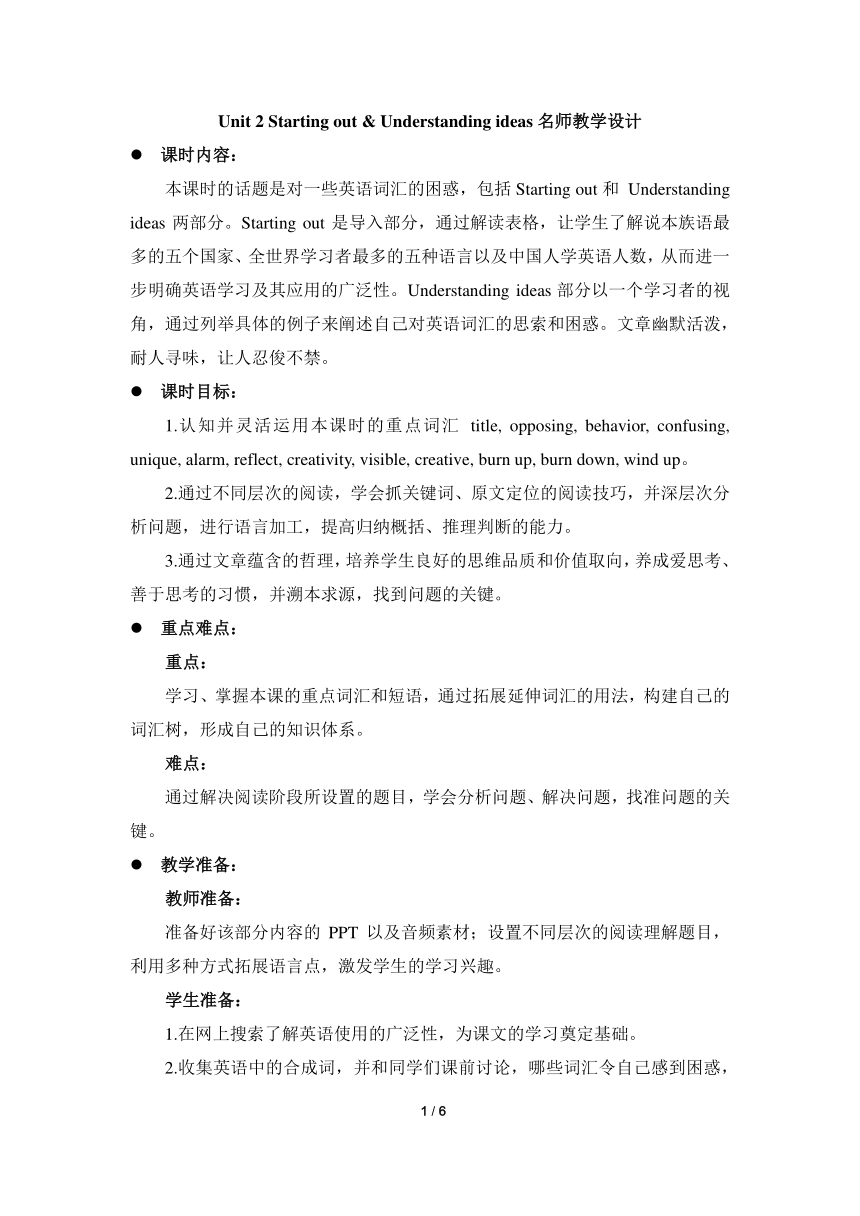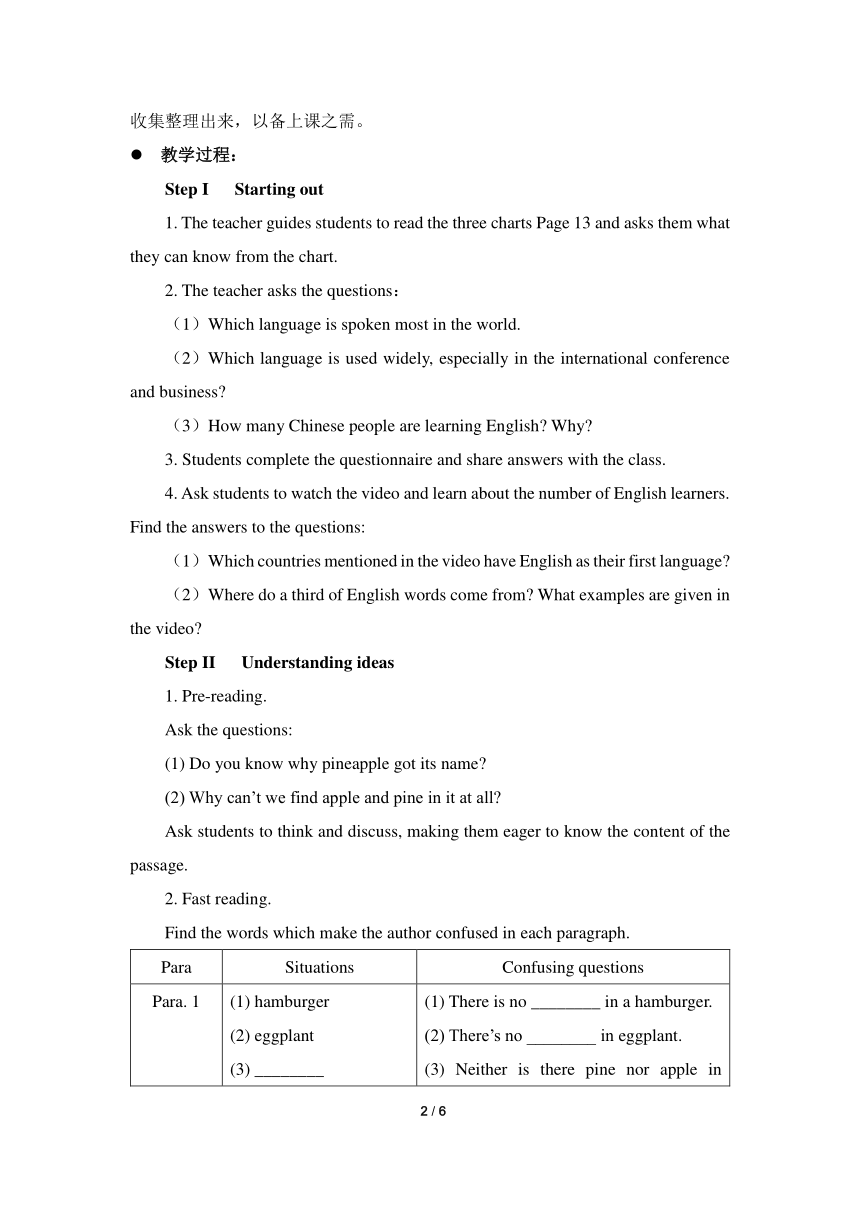外研版(2019)必修 第一册Unit 2 Exploring English Starting out & Understanding ideas名师教学设计
文档属性
| 名称 | 外研版(2019)必修 第一册Unit 2 Exploring English Starting out & Understanding ideas名师教学设计 |  | |
| 格式 | docx | ||
| 文件大小 | 21.8KB | ||
| 资源类型 | 教案 | ||
| 版本资源 | 外研版(2019) | ||
| 科目 | 英语 | ||
| 更新时间 | 2023-02-26 09:17:49 | ||
图片预览



文档简介
Unit 2 Starting out & Understanding ideas名师教学设计
课时内容:
本课时的话题是对一些英语词汇的困惑,包括Starting out和 Understanding ideas两部分。Starting out是导入部分,通过解读表格,让学生了解说本族语最多的五个国家、全世界学习者最多的五种语言以及中国人学英语人数,从而进一步明确英语学习及其应用的广泛性。Understanding ideas部分以一个学习者的视角,通过列举具体的例子来阐述自己对英语词汇的思索和困惑。文章幽默活泼,耐人寻味,让人忍俊不禁。
课时目标:
1.认知并灵活运用本课时的重点词汇 title, opposing, behavior, confusing, unique, alarm, reflect, creativity, visible, creative, burn up, burn down, wind up。
2.通过不同层次的阅读,学会抓关键词、原文定位的阅读技巧,并深层次分析问题,进行语言加工,提高归纳概括、推理判断的能力。
3.通过文章蕴含的哲理,培养学生良好的思维品质和价值取向,养成爱思考、善于思考的习惯,并溯本求源,找到问题的关键。
重点难点:
重点:
学习、掌握本课的重点词汇和短语,通过拓展延伸词汇的用法,构建自己的词汇树,形成自己的知识体系。
难点:
通过解决阅读阶段所设置的题目,学会分析问题、解决问题,找准问题的关键。
教学准备:
教师准备:
准备好该部分内容的PPT以及音频素材;设置不同层次的阅读理解题目,利用多种方式拓展语言点,激发学生的学习兴趣。
学生准备:
1.在网上搜索了解英语使用的广泛性,为课文的学习奠定基础。
2.收集英语中的合成词,并和同学们课前讨论,哪些词汇令自己感到困惑,收集整理出来,以备上课之需。
教学过程:
Step I Starting out
1. The teacher guides students to read the three charts Page 13 and asks them what they can know from the chart.
2. The teacher asks the questions:
(1)Which language is spoken most in the world.
(2)Which language is used widely, especially in the international conference and business
(3)How many Chinese people are learning English Why
3. Students complete the questionnaire and share answers with the class.
4. Ask students to watch the video and learn about the number of English learners. Find the answers to the questions:
(1)Which countries mentioned in the video have English as their first language
(2)Where do a third of English words come from What examples are given in the video
Step II Understanding ideas
1. Pre-reading.
Ask the questions:
(1) Do you know why pineapple got its name
(2) Why can’t we find apple and pine in it at all
Ask students to think and discuss, making them eager to know the content of the passage.
2. Fast reading.
Find the words which make the author confused in each paragraph.
Para Situations Confusing questions
Para. 1 (1) hamburger (2) eggplant (3) ________ (1) There is no ________ in a hamburger. (2) There’s no ________ in eggplant. (3) Neither is there pine nor apple in pineapple.
Para. 2 (1) sculpt a sculpture / paint a painting (2) traveling (3) home (1) Why do we use “________” when having photos taken (2) in the car/ taxi, but ________ the train/ bus (3) Seasick, airsick, carsick, but what does ________ mean (4) ________ or housework
Para. 3 (1) Why are “________” and “softly” not an opposing pair (2) Why are shameless and shameful behaviors the same
Para. 4 weather It’s raining/ snowing. Why can’t we say “it’s ________” when it is fine
Para. 5 ________ What does it mean in a ________ report What about IT and US
Para. 6 (1) a house (2) a form (3) an alarm (1) burn ________ or burn down (2) fill in or fill ________ (3) only heard once it goes off
Para. 7 (1) be out (2) ________ (1) the ________ or the lights (2) one’s watch or the passage
Keys:
Para.1:(1)ham(2)egg(3)pineapple
Para.2:(1)take(2)on(3)homesick(4)homework
Para.3:(1)hardly(2)harmful
Para.4:sunshining
Para.5.WHO:medical
Para.6:(1)up(2)out
Para.7:(1)stars(2)wind up
【设计意图】该部分用表格的形式将课文的主要内容呈现出来,一目了然,让学生学会根据所设置的空白处查找关键信息。该表格理清了文章脉络,对学生分析问题、概括总结、提炼主题很有帮助。
3. Careful reading.
Read the passage again and complete the text.
Many people often have difficulty in learning English. Once my little son asked me whether there was ham in a hamburger. I remembered there were not eggs in eggplant, either. 1. ________ is there pine nor apple in pineapple, so I began to understand why so many people think English hard 2. ________ (learn). For example, we choose different 3. ________ (verb) when describing things. We can sculpt a sculpture or paint a painting, 4. ________ when it comes to a photo, we use “take”. Different prepositions also confuse us. While 5. ________ (travel), we are in the car or taxi but on the train or bus. “Homesick” has different meaning, compared with seasick, airsick and car sick. “Hard” is the opposite of “soft”, but how about “hardly” and “softly” When we look out of the window, we can say “it 6. ________ (rain)” but we can’t express the sunshine in the same way. There are also some other 7. ________ (confuse) questions in English learning. A house can burn up as it burns down. You fill in a form by 8. ________ (fill) it out. An alarm can 9. ________ only (hear) once it goes off. English was invented by people, 10. ________ reflects the creativity of the human race. When the stars are out, they are visible, but when lights are out, they are invisible.
Keys:1. Neither 2. to learn 3. verbs 4. but 5. traveling 6. is raining 7. Confusing 8. filling 9. be; heard 10. which
【设计意图】本文是原文的概括归纳,通过设置该题,帮助学生进一步理解原文,理清文章脉络,锻炼概括提升能力。同时,通过具体题目的设置,锻炼、提升学生分析语境,解决问题的能力。同时,该题型侧重语篇考查,将英语词汇、语法,句法上的运用综合在语篇中,更科学地反映学生的英语综合能力。
4. Language points.
Master the words and phrases: title, opposing, behavior, confusing, unique, alarm, reflect, creativity, visible, creative, burn up, burn down, wind up
【备注】部分知识点讲解详见第二教案。
5. Post-reading.
Finish Activity 3, 4 & 5 on Page 16.
(1)Activity 3以选择的形式设题,考查文章的写作意图。文章第一段导出话题“Have you ever asked yourself why people often have trouble learning English I hadn’t, until one day my five-year-old son asked me whether there was ham in a hamburger.”作者开始并没有觉得英语难学,直到5岁的儿子提了一个 hamburger里是否有ham的问题,引发了作者的思考。下文列举的具体例子都是阐述上述问题,对英语学习者来说,都是很困惑的问题。因此文章前两句即点明主旨和意图,由此可判断与第一项相符,从而得出正确答案。
(2)Activity 4是通过表格的形式,将原文要点提炼出来,要学生们按图索骥,找出正确答案。该题源自原文,回扣文章,难度不大。
(3)Activity 5解释了上文中的困惑,根据 pineapple、hamburger、eggplant的来源解释了其构词和含义。有助于学生进一步理解英语词汇的来源和含义,加深对文章的理解。
Step Ⅲ Sum up
1.总结本节课的重点词汇、短语和句型,采用表格、思维导图等形式更清晰地了解它们的用法,并形成知识脉络。
2.让学生用简短的英语分享、复述文章中提到的令作者困惑的词汇,锻炼学生提炼要点和口头表达能力。
3.和学生分享几个学英语的技巧,引导学生多探求新知。尽管英语复杂、不容易掌握,但“冰冻三尺非一日之寒”,鼓励学生贵在坚持,将英语学习和培养学生良好的品质和素养结合起来。
【设计意图】英语教学中既让学生掌握英语基础知识,也要将道德感情、英语思维能力、意识渗透在里面。让学生通过学习,既可以提高学科知识,又可以获得学科素养,使学生终生受益。
Step IV Homework
1. Sum up what we learned in class and take notes.
2. Preview the next period.
板书设计:
Unit 2 Exploring English Period I Starting out & Understanding ideas I. Starting out Which language is spoken most in the world Which language is used widely, especially in the international conference and business How many Chinese people are learning English Why II. Understanding ideas 1. Pre-reading 2. Fast reading: Fill in the form. 3. Careful reading. 4. Language points. title, opposing, behavior, confusing, unique, alarm, reflect, creativity, visible, creative, burn up, burn down, wind up Post-reading: Finish Activity 3, 4 & 5 on Page 16. Ⅲ. Sum up Ⅳ. Homework
2 / 2
课时内容:
本课时的话题是对一些英语词汇的困惑,包括Starting out和 Understanding ideas两部分。Starting out是导入部分,通过解读表格,让学生了解说本族语最多的五个国家、全世界学习者最多的五种语言以及中国人学英语人数,从而进一步明确英语学习及其应用的广泛性。Understanding ideas部分以一个学习者的视角,通过列举具体的例子来阐述自己对英语词汇的思索和困惑。文章幽默活泼,耐人寻味,让人忍俊不禁。
课时目标:
1.认知并灵活运用本课时的重点词汇 title, opposing, behavior, confusing, unique, alarm, reflect, creativity, visible, creative, burn up, burn down, wind up。
2.通过不同层次的阅读,学会抓关键词、原文定位的阅读技巧,并深层次分析问题,进行语言加工,提高归纳概括、推理判断的能力。
3.通过文章蕴含的哲理,培养学生良好的思维品质和价值取向,养成爱思考、善于思考的习惯,并溯本求源,找到问题的关键。
重点难点:
重点:
学习、掌握本课的重点词汇和短语,通过拓展延伸词汇的用法,构建自己的词汇树,形成自己的知识体系。
难点:
通过解决阅读阶段所设置的题目,学会分析问题、解决问题,找准问题的关键。
教学准备:
教师准备:
准备好该部分内容的PPT以及音频素材;设置不同层次的阅读理解题目,利用多种方式拓展语言点,激发学生的学习兴趣。
学生准备:
1.在网上搜索了解英语使用的广泛性,为课文的学习奠定基础。
2.收集英语中的合成词,并和同学们课前讨论,哪些词汇令自己感到困惑,收集整理出来,以备上课之需。
教学过程:
Step I Starting out
1. The teacher guides students to read the three charts Page 13 and asks them what they can know from the chart.
2. The teacher asks the questions:
(1)Which language is spoken most in the world.
(2)Which language is used widely, especially in the international conference and business
(3)How many Chinese people are learning English Why
3. Students complete the questionnaire and share answers with the class.
4. Ask students to watch the video and learn about the number of English learners. Find the answers to the questions:
(1)Which countries mentioned in the video have English as their first language
(2)Where do a third of English words come from What examples are given in the video
Step II Understanding ideas
1. Pre-reading.
Ask the questions:
(1) Do you know why pineapple got its name
(2) Why can’t we find apple and pine in it at all
Ask students to think and discuss, making them eager to know the content of the passage.
2. Fast reading.
Find the words which make the author confused in each paragraph.
Para Situations Confusing questions
Para. 1 (1) hamburger (2) eggplant (3) ________ (1) There is no ________ in a hamburger. (2) There’s no ________ in eggplant. (3) Neither is there pine nor apple in pineapple.
Para. 2 (1) sculpt a sculpture / paint a painting (2) traveling (3) home (1) Why do we use “________” when having photos taken (2) in the car/ taxi, but ________ the train/ bus (3) Seasick, airsick, carsick, but what does ________ mean (4) ________ or housework
Para. 3 (1) Why are “________” and “softly” not an opposing pair (2) Why are shameless and shameful behaviors the same
Para. 4 weather It’s raining/ snowing. Why can’t we say “it’s ________” when it is fine
Para. 5 ________ What does it mean in a ________ report What about IT and US
Para. 6 (1) a house (2) a form (3) an alarm (1) burn ________ or burn down (2) fill in or fill ________ (3) only heard once it goes off
Para. 7 (1) be out (2) ________ (1) the ________ or the lights (2) one’s watch or the passage
Keys:
Para.1:(1)ham(2)egg(3)pineapple
Para.2:(1)take(2)on(3)homesick(4)homework
Para.3:(1)hardly(2)harmful
Para.4:sunshining
Para.5.WHO:medical
Para.6:(1)up(2)out
Para.7:(1)stars(2)wind up
【设计意图】该部分用表格的形式将课文的主要内容呈现出来,一目了然,让学生学会根据所设置的空白处查找关键信息。该表格理清了文章脉络,对学生分析问题、概括总结、提炼主题很有帮助。
3. Careful reading.
Read the passage again and complete the text.
Many people often have difficulty in learning English. Once my little son asked me whether there was ham in a hamburger. I remembered there were not eggs in eggplant, either. 1. ________ is there pine nor apple in pineapple, so I began to understand why so many people think English hard 2. ________ (learn). For example, we choose different 3. ________ (verb) when describing things. We can sculpt a sculpture or paint a painting, 4. ________ when it comes to a photo, we use “take”. Different prepositions also confuse us. While 5. ________ (travel), we are in the car or taxi but on the train or bus. “Homesick” has different meaning, compared with seasick, airsick and car sick. “Hard” is the opposite of “soft”, but how about “hardly” and “softly” When we look out of the window, we can say “it 6. ________ (rain)” but we can’t express the sunshine in the same way. There are also some other 7. ________ (confuse) questions in English learning. A house can burn up as it burns down. You fill in a form by 8. ________ (fill) it out. An alarm can 9. ________ only (hear) once it goes off. English was invented by people, 10. ________ reflects the creativity of the human race. When the stars are out, they are visible, but when lights are out, they are invisible.
Keys:1. Neither 2. to learn 3. verbs 4. but 5. traveling 6. is raining 7. Confusing 8. filling 9. be; heard 10. which
【设计意图】本文是原文的概括归纳,通过设置该题,帮助学生进一步理解原文,理清文章脉络,锻炼概括提升能力。同时,通过具体题目的设置,锻炼、提升学生分析语境,解决问题的能力。同时,该题型侧重语篇考查,将英语词汇、语法,句法上的运用综合在语篇中,更科学地反映学生的英语综合能力。
4. Language points.
Master the words and phrases: title, opposing, behavior, confusing, unique, alarm, reflect, creativity, visible, creative, burn up, burn down, wind up
【备注】部分知识点讲解详见第二教案。
5. Post-reading.
Finish Activity 3, 4 & 5 on Page 16.
(1)Activity 3以选择的形式设题,考查文章的写作意图。文章第一段导出话题“Have you ever asked yourself why people often have trouble learning English I hadn’t, until one day my five-year-old son asked me whether there was ham in a hamburger.”作者开始并没有觉得英语难学,直到5岁的儿子提了一个 hamburger里是否有ham的问题,引发了作者的思考。下文列举的具体例子都是阐述上述问题,对英语学习者来说,都是很困惑的问题。因此文章前两句即点明主旨和意图,由此可判断与第一项相符,从而得出正确答案。
(2)Activity 4是通过表格的形式,将原文要点提炼出来,要学生们按图索骥,找出正确答案。该题源自原文,回扣文章,难度不大。
(3)Activity 5解释了上文中的困惑,根据 pineapple、hamburger、eggplant的来源解释了其构词和含义。有助于学生进一步理解英语词汇的来源和含义,加深对文章的理解。
Step Ⅲ Sum up
1.总结本节课的重点词汇、短语和句型,采用表格、思维导图等形式更清晰地了解它们的用法,并形成知识脉络。
2.让学生用简短的英语分享、复述文章中提到的令作者困惑的词汇,锻炼学生提炼要点和口头表达能力。
3.和学生分享几个学英语的技巧,引导学生多探求新知。尽管英语复杂、不容易掌握,但“冰冻三尺非一日之寒”,鼓励学生贵在坚持,将英语学习和培养学生良好的品质和素养结合起来。
【设计意图】英语教学中既让学生掌握英语基础知识,也要将道德感情、英语思维能力、意识渗透在里面。让学生通过学习,既可以提高学科知识,又可以获得学科素养,使学生终生受益。
Step IV Homework
1. Sum up what we learned in class and take notes.
2. Preview the next period.
板书设计:
Unit 2 Exploring English Period I Starting out & Understanding ideas I. Starting out Which language is spoken most in the world Which language is used widely, especially in the international conference and business How many Chinese people are learning English Why II. Understanding ideas 1. Pre-reading 2. Fast reading: Fill in the form. 3. Careful reading. 4. Language points. title, opposing, behavior, confusing, unique, alarm, reflect, creativity, visible, creative, burn up, burn down, wind up Post-reading: Finish Activity 3, 4 & 5 on Page 16. Ⅲ. Sum up Ⅳ. Homework
2 / 2
